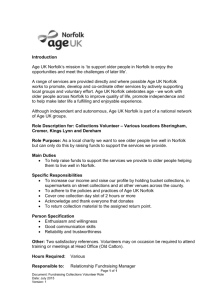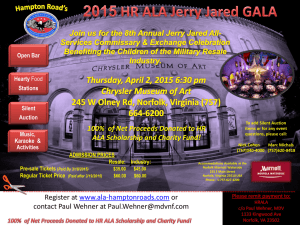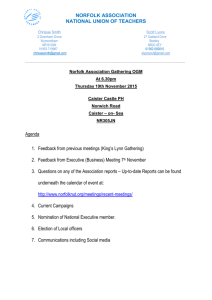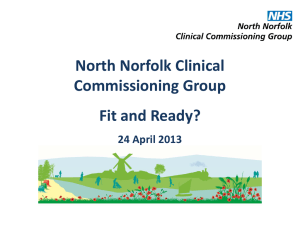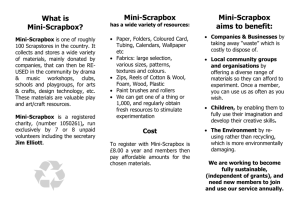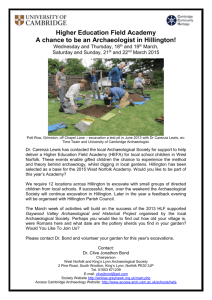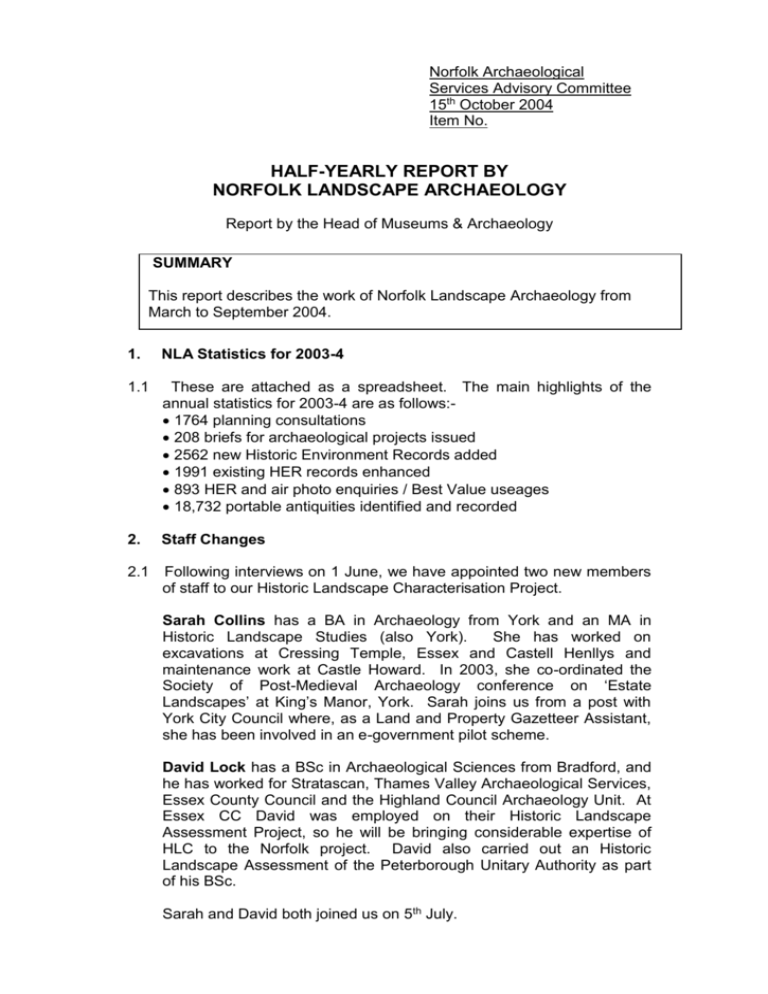
Norfolk Archaeological
Services Advisory Committee
15th October 2004
Item No.
HALF-YEARLY REPORT BY
NORFOLK LANDSCAPE ARCHAEOLOGY
Report by the Head of Museums & Archaeology
SUMMARY
This report describes the work of Norfolk Landscape Archaeology from
March to September 2004.
1.
NLA Statistics for 2003-4
1.1
These are attached as a spreadsheet. The main highlights of the
annual statistics for 2003-4 are as follows: 1764 planning consultations
208 briefs for archaeological projects issued
2562 new Historic Environment Records added
1991 existing HER records enhanced
893 HER and air photo enquiries / Best Value useages
18,732 portable antiquities identified and recorded
2.
Staff Changes
2.1 Following interviews on 1 June, we have appointed two new members
of staff to our Historic Landscape Characterisation Project.
Sarah Collins has a BA in Archaeology from York and an MA in
Historic Landscape Studies (also York).
She has worked on
excavations at Cressing Temple, Essex and Castell Henllys and
maintenance work at Castle Howard. In 2003, she co-ordinated the
Society of Post-Medieval Archaeology conference on ‘Estate
Landscapes’ at King’s Manor, York. Sarah joins us from a post with
York City Council where, as a Land and Property Gazetteer Assistant,
she has been involved in an e-government pilot scheme.
David Lock has a BSc in Archaeological Sciences from Bradford, and
he has worked for Stratascan, Thames Valley Archaeological Services,
Essex County Council and the Highland Council Archaeology Unit. At
Essex CC David was employed on their Historic Landscape
Assessment Project, so he will be bringing considerable expertise of
HLC to the Norfolk project. David also carried out an Historic
Landscape Assessment of the Peterborough Unitary Authority as part
of his BSc.
Sarah and David both joined us on 5th July.
Ken Hamilton has been appointed to the post of Great Yarmouth
Archaeological Map Project Officer. Ken has a BSc, MSc and PhD
from the University of Bradford, the last on the subject of the
archaeological assessment of urban and brownfield sites by
geophysical prospection. Ken has worked previously with GSB
Prospection, Cheshire County Council, West Yorkshire Archaeology
Services, Bradford University and as a geophysical consultant and
project engineer.
2.2
In order to avoid any possible confusion between the role of NLA and
that of Development Control Officers working within the LPAs, the post
of Development Control Officer has been renamed Planning Advisory
Archaeologist.
The current post holder, Edwin Rose, recently
celebrated thirty years with the NM&AS.
3.
Building improvements
3.1 Since the last meeting, the following building improvements have been
made to the A&E wing: New roof
Provision of additional power sockets and LAN points
New office lighting
New ramped main entrance
4.
Best Value Performance Indicators
4.1 In the period March to August 2004, the following BVPI 170 ‘Museum
Usages’ were recorded by Norfolk Landscape Archaeology staff:Planning
1074
Historic Environment Record
339
Norfolk Air Photo Library
89
Identification and Recording Service 196
Other
200
Total
1898
4.2 The number of people involved in NLA ‘Outreach’ Events was 1839.
5.
The Norfolk Historic Environment Record
5.1 Over 1000 new sites have been added to the NHER database since the
last report. Over 1500 existing sites have been enhanced.
5.2 There were almost 200 HER enquiries since March.
5.3 Presentations on the HER have been given to the Friends of Norfolk
Museums, to the staff of the Norfolk Record Office as one of their inservice training sessions, and an INSET talk to teachers on using
historic environment records for teaching history.
5.4 The slight backlog of new and enhanced sites waiting to be input onto
the HER which developed in the three months when the Assistant
Records Officer post was unfilled has been eradicated.
5.5 The new upgrade of the HBSMR software, v3, was installed in June and
is bedding in. exeGesIS SDM Ltd undertook this for us, ably assisted
by Alice Cattermole, our recently-appointed Assistant Records Officer.
Some time was then spent identifying and resolving issues relating to
the new software. Within the new software, additional functionality in the
form of an ‘HLC module’ will enable the HLC project to add their data
directly to the HER.
5.6 The new software has facilitated more efficient data cleansing, thereby
increasing consistency within the HER. We are currently focussing in
particular on sources.
5.7 The pilot phase of OASIS (Online Access to the Index of Archaeological
Investigations) is completed, and the project has now been rolled out.
The Advisory Committee will recall that both NLA and the NAU
participated in the OASIS pilot phase, and had a significant impact upon
the final project design. All contractors undertaking archaeological work
in the county must now submit an electronic OASIS form, which is then
validated and passed on to the NMR and the HER. The OASIS website
is at:- http://ads/ahds.ac.uk/project/oasis/
5.8 Targeted HER enhancement has included the area of the Coastal
Survey and Holkham Park, and also the Sedgeford area as a result of
the exchange of HER information with SHARP members.
5.9 One of our volunteers, Terry Miller, is working through the late Alan
Carter’s building survey records in preparation for incorporating this
material into the HER.
5.10 Material from the Norfolk HER will be used in the publication
‘Suffolk’s Ancient Sites – Historic Places,’ as well as in a variety of
undergraduate, MA and PhD dissertations. HER information has been
used to inform RAF excavation licences, field surveys in Lexham and
Litcham and Norfolk Wildlife Trust’s management plans. Members of
the public have continued to use the HER for local history research, for
continuing education purposes and, to quote one visitor’s response to
‘What is the reason for your enquiry?’ - “Curiosity”.
5.11 Finally, it is worth noting a recent Norfolk HER policy decision, which
is fully to implement the Event – Monument – Source data model.
This divides the information being collected in the HER into:Events: activity at a particular time and place and usually involving a
single archaeological technique e.g. October 2004, evaluation, Great
Yarmouth
Sources: data or archive collected during events and any subsequent
publications or interpretations e.g. ‘An Evaluation at Great Yarmouth,
October 2004’, Norfolk Archaeological Unit Report No. 789.
Monuments: the conclusions drawn regarding the nature of the
archaeological remains on a site e.g. Bronze Age round barrow.
This simple yet flexible model allows HERs to frame their
archaeological data in a consistent way, which not only aids the
consistency and reliability of the data but also allows HER datasets to
be more easily compared and integrated.
6.
The Norfolk Air Photo Library
6.1
There have been just under 100 air photo enquiries since the last
report.
6.2
An NAPL image of the Roman fort at Burgh Castle has been used in
the new ‘Time and Tide’ museum at Great Yarmouth, and will be used
on a selection of historic tours given in North Norfolk.
6.3
NAPL photos will also be used in ‘The Book of Narborough’ (part of the
Halsgrove Community History series) and in the East Anglia edition of
a book series to be released by EH and Harper Collins called
‘England’s Landscape.’
6.4
NAPL material will also be shown in an episode of the October Films
television series ‘Time Trail,’ to be shown on ITV in late September.
7.
The Norfolk E-Map Explorer
7.1 Improvements are being planned for the Norfolk E-Map Explorer
website, including the following: A page rounding up all the reproduction options
The ability to view one map full-screen, retaining all the navigation
features, at higher quality (although the quality will not be such
that users are able to make high-quality prints).
The ability to zoom out further than 1 km, to 5km.
7.2 The Norfolk E-map Explorer can be found at www.historicmaps.norfolk.gov.uk
8.
Development Control and Planning
8.1 In the first two quarters of 2004 (January to June) there were: 957 planning consultations
and
101 Briefs for projects were issued.
8.2
Work has continued on the development of the Standards for Field
Archaeology in the East of England (East Anglian Archaeology
Occ.Pap. 14) into a national Benchmarks document. The production of
a draft Benchmarks document by the end of 2004 has been agreed as
a performance indicator by the Association of Local Government
Archaeological Officers (ALGAO) and English Heritage.
9.
Historic Buildings
9.1 Work on investigation and recording of buildings continues, mainly due
to District Councils asking NLA to comment on Listed Building and
other applications.
9.2
Recent discoveries of importance in secular buildings or work
undertaken include: the remains of an aisled hall enclosed in a later building at the Old
Rectory, Shelfanger (South Norfolk)
a rare medieval first floor corridor at the Old Hall, Besthorpe
(Breckland)
an 18th century servants’ punishment room at the Old Bull, East
Harling (Breckland)
in East Harling (Breckland) an interesting 19th century clay lump
house was assessed before demolition and a recording condition
attached to the planning consent
at Methwold, (West Norfolk) details of the concealed 17 th century
structure of Hall Farm exposed during emergency repairs were
recorded.
The clock tower at Watton (Breckland) was examined prior to
restoration.
The church of St Wandregesilius at Bixley (South Norfolk) was
gutted by fire and a salvage record was made and
recommendations for further action compiled.
Restoration work at Stockton church (South Norfolk) revealed
medieval tiles used to top out the walls, a possibly unique
occurrence.
Similar works at Foulsham (Broadland) produced a blocked
doorway to a lost parvis (room above the porch)
At Wiveton (North Norfolk) an Easter sepulchre was exposed.
Advice was given to church architects regarding Wretton (West
Norfolk) and Horningtoft (Breckland) churches
Statements of Significance were prepared for churches at
Brettenham (Breckland) and Whittington (West Norfolk).
The Planning Advisory Archaeologist attended an EH seminar at St
Nicholas Chapel, King’s Lynn (West Norfolk) to discuss how to
conserve the unique medieval painted doors.
10. Urban work
The following sections offer a curatorial overview (by Andy Hutcheson)
of archaeological work in Norfolk’s urban areas, covering work by the
NAU and other contractors.
10.1 Great Yarmouth
A separate report on the Great Yarmouth Archaeological Map has
been provided.
10.2 King’s Lynn
King’s Lynn continues to enjoy a development boom, which is resulting
in a parallel boom in archaeological research. Oxford Archaeology are
presently conducting a large scale programme, the largest single
archaeological investigation in the town’s history since the King’s Lynn
Survey. Oxford have recently discovered a well-preserved sequence of
medieval building remains on the New Conduit Street frontage. Several
impressive limestone wall-footings of 14th and 15th century date have
been excavated (see picture). The earliest evidence is of consolidation
of the marsh associated with the Purfleet during the 13th century,
through the dumping of what appears to be industrial waste, possibly
from iron working. The burnt nature of some of the silts may represent
debris from salt working.
Oxford Archaeology at work on the New Conduit Street Frontage
Picture taken by Andy Hutcheson
This ties in thematically with Archaeological Project Service’s work,
now nearing completion, at the Queen Mary’s Nurses Home site,
where a 13th century salt producing industry was situated.
Oxford are now moving into another major excavation area on the
Broad Street frontage, where previously evaluation indicated that 12 th
century settlement is to be found.
In addition, both Archaeological Solutions (formerly the Hertfordshire
Archaeological Trust) and Pre-Construct Archaeology have recently
carried out evaluations of plots in the town in advance of
developments.
Archaeological Solutions excavated a trench on King Street, where a
deeply stratified sequence of structural deposits was uncovered.
Pre-Construct’s work on the other side of the old town, on Blackfriars
Road, illustrated a sequence beginning with a previously-unknown
medieval watercourse with marshy conditions on its periphery. This
stream was infilled in the 17th century and environmental evidence
showed that during the late 15th and 16th century the marsh
surrounding the watercourse was well managed, drained and utilised,
probably as pasture.
10.3 Norwich
The Norfolk Archaeological Unit evaluated a proposed development
site on the south side of Fishergate, next to the site excavated by Brian
Ayers in the late 1980s, which produced important evidence for 8 th and
9th century activity, perhaps representing the North wic that gave the
city its name. The evidence from the evaluation showed a wellpreserved sequence of structures and boundaries on the Fishergate
street-frontage, dating from the Late Saxon period (AD 850-1066).
Towards the river there was a sequence of marsh in-fill deposits very
similar to those discovered by Ayers. There was here too a significant
quantity of 8th and 9th century pottery, including the regionally
ubiquitous Ipswich Ware as well as Badorf amphora sherds,
suggesting that wine was being imported into the town at this time.
Riverside trench at 40 Fishergate
Other recent work by the NAU within the City includes an excavation at
Suckling House in advance of the redevelopment of Cinema City. A
remarkable discovery was made in the courtyard, where a large ditch
was uncovered, which is thought to be the southern defensive ditch for
the Late Saxon town. Topographically, the position makes sense and it
is in alignment with the better-understood defences to the north of the
river.
11. Coastal work
11.1 Holme-next-the-Sea
Monitoring work by the Archaeology and Environment Division
continues bi-monthly, funded by English Heritage. Radiocarbon dating
for many of the wooden structures is anticipated very soon. Trial work
beside the Second Circle has revealed that only 300mm to 400mm of
the timbers survives unaffected. The upper 450mm of each timber has
been degraded through parasitic activity, such as boring molluscs.
Therefore, time is growing short and a strategy will be formulated for
further recording and analysis of this monument within the next couple
of months.
12. Ancient Woodland Survey Results
12.1 This survey investigated the above ground evidence for the historic
environment in approximately 12% of the county's ancient woodland.
12.2 A total of 162 features have been identified and recorded within the 15
woods inspected. The major feature types are listed below, with the
overall number of sites in each type. In most woods, the boundary
bank, if existing, is often subdivided into several sections of differing
form.
12.3 Features recorded include: 48 wood banks
27 subdividing and fragmentary banks and ditches
1 moat
11 enclosure fragments
7 linear
15 ponds
2 barrows
20 extraction pits
14 other depressions
3 burnt flint scatters
12.4 Sites of particular importance include: Wood banks in Woodrising, Tindall, Reffley, Swanton Novers Great
and Little, and Wayland Woods.
Internal subdivisions and linear features in Woodrising and Swanton
Great and Little Woods.
Moat in Hedenham Wood.
Hollow ways in Felbrigg Great Wood.
Possible barrows in Swanton and Felbrigg Great Woods.
Artefacts in Wayland Wood.
12.5 The amount of detail noted in the sample inspected, provides a guide
to the total amount that could be expected for the remainder of the
county. If the pilot study area is representative, then a survey of the
further 88% of Norfolk’s ‘ancient woodland’ would identify a further
1350 sites and perhaps as many as 80 sites which require either
protection through designation and/or through positive management.
12.6 The results of the survey are to be presented to a special meeting of
the funding partners and key stakeholders at Gressenhall on 29 th
September, and future survey work will be discussed. The results of
that meeting will be presented orally.
13. The Norfolk National Mapping Project
13.1 The Norfolk NMP team is still working around the north east coast of
the county, with the Bacton, Mundesley and Sea Palling areas
currently being mapped. In the last six months the team has recorded
around 250 new sites and amended details of over 100 existing
monuments. An interim report has been prepared for Norfolk
Archaeology.
13.2 The team has just finished recording the World War Two military
defences in and around Cromer, which consisted of a complex
network of gun emplacements, pillboxes and trenches. This mapping
included the large coastal battery at the end of Cliff Drive and three of
the communal trench shelters constructed to protect the inhabitants
during air raids. The radar station at Happisburgh and its associated
defences were also mapped.
An example of NMP mapping.
The cropmarks of a possible Romano-British farmstead and RomanoBritish to post-medieval field systems in Northrepps, North Norfolk.
NMP mapping © NMAS. Base map Ordnance Survey © copyright. All
rights reserved. NCC licence number 076759.2000
13.3 The mapping has included several possible new ring ditches,
enclosures and trackways, in particular large swathes of multi-period
field systems and enclosures were mapped in Northrepps and
Happisburgh parishes.
13.4 Sarah Massey gave a paper on the prehistoric sites in Norfolk
mapped by the NMP at the ‘Suffolk’s Coastal Archaeology’ Day
School on Southwold Pier in June.
13.5 A morning was also spent talking to the University of East Anglia
Landscape History Masters students about the uses of aerial
photographs for archaeologists and the results of the NMP Project.
This is intended to become an annual event.
13.6 Sophie Tremlett gave a paper on Neolithic causewayed enclosures in
North East Norfolk at the Aerial Archaeology Research Group and
Neolithic Studies Group Conference in Munich in early September.
14. Historic Landscape Characterisation
14.1 The Historic Landscape Characterisation team started work in July,
and have spent the first few months on project setup, background
reading, familiarisation, refinement of methodology, sample areas and
training.
14.2 Mapping and characterisation will then progress as follows: The Broads
North Norfolk coast and north west Norfolk
Central North Norfolk
North east Norfolk and Flegg
Mid Norfolk
The Fens
South Norfolk claylands
Breckland
14.3 The Advisory Committee will receive regular progress reports on the
HLC project and, at some future meeting, a presentation by project
staff.
14.4 The start of the project has been marked by a presentation / launch on
8 October, when a large group of stakeholders attended an event at
the Archive Centre. An oral report on the event will be given at the
meeting.
14.5 There is further information about the Norfolk HLC Project on the
What’s
New
section
of
the
NM&AS
website.
www.museums.norfolk.gov.uk
15. The Norfolk Heritage Explorer
15.1 The bid to the HLF to make the information held in the Norfolk Historic
Environment Record has been completed, and submitted to the HLF.
15.2 The project has two mains aims:
to create user-friendly summaries of each of 40,000 NHER records,
and to make these available on the web, with supporting and
interpretative information
to deliver a programme of outreach about the Explorer, the HER
and the historic environment.
15.3 The project would employ four staff for 1 to 1.5 years, starting in July
2005 and ending in June 2007, at a total cost of £ 138,250. The
application to the HLF is for 90% of the costs.
16. The Identification and Recording Service for Archaeological Finds
Recent finds of particular importance include the following: A Palaeolithic handaxe (Great Yarmouth)
A Late Iron Age hoard of two terrets and fragment of harness
mount, from South Norfolk.
Possible evidence of the counterfeiting of Roman coins, at Burgh
Castle (Great Yarmouth).
An Early Saxon gold bracteate depicting a figure wielding a sword
and a beaked quadruped. Dated to the late 5th century AD, and dielinked to another in a hoard from Schleswig Holstein, Denmark.
From North Norfolk.
(This is the third Norfolk gold bracteate, all with a very tight
distribution.
They are exciting enormous interest amongst
continental specialists).
A Kentish silver gilt garnet inlaid disc brooch found with a silver gilt
suspension ring, 6th century AD. From North Norfolk.
Another “new” late 5th- to 6th-century AD inhumation cemetery
evidenced by metalwork in the ploughsoil. West Norfolk.
A large and very elaborately decorated Early Saxon “chip carved”
gilt bronze mount, probably from a casket. From Breckland.
A bronze coin of Carausius (AD 286-93) of the very rare ‘triple bust’
type. From South Norfolk.
17. Other Outreach
Ancient Woodlands – Radio Norfolk
Tour of offices by the Friends of Norwich Museums
Tour of offices by Bill Bryson, Commissioner, English Heritage
Reports to Area Museum Committees – North Norfolk, King’s Lynn and
West Norfolk, Great Yarmouth
Tour of Warham Camp for U3A
Pudding Norton deserted medieval village – Radio Norfolk
NLA staff continue to sit on the following external committees:
Norfolk and Norwich Archaeological Society Council
CBA East Anglia
Holme Working Group
ALGAO Maritime Committee
ALGAO Planning & Legislation Committee
ALGAO Urban Committee
Caistor Roman Town Joint Advisory Board
Society for Medieval Archaeology
Norfolk Heraldry Society
Diocesan Advisory Committees
18. The Archaeology & Environment Open Day 2004
18.1 As part of National Archaeology Weekend, the Archaeology &
Environment Division held an Open Day at its offices at Gressenhall on
Sunday 18th July.
18.2 Visitors to Gressenhall were able to go on ‘Behind the Scenes’ visits
to: The Norfolk Air Photo Library and National Mapping Programme
The Norfolk E-Map Explorer
The Norfolk Historic Environment Record
The Norfolk Biological Record
The Identification and Recording Service for Archaeological Finds
The Norfolk Archaeological Unit Finds Department
The Norfolk Historic Landscape Characterisation Project
The Norwich Urban Archaeological Database
18.3 Other attractions included: Short talks on Roman coins
Roman helmet and armour to try on
Displays
Objects to handle
18.4 More than 200 people visited the Open Day, despite heavy and
continuous rain for most of the morning!
18.5 Comments on the event included the following:It was great. We learned new things. Thank you.
We found useful information. Thanks.
Now we know who to contact about the history of our area!
I liked it because I got 2 try on a helnat.
Enlightening and informative.
I’m going to join the Young Archaeologists Club.
It was really fun.
Really interesting. All the staff were so helpful.
I enjoyed trying on the Roman helmet and touching the items. I learnt
new facts. Thank you.
Very interesting talk.
Will you be doing something next year?
It’s just amazing to find out about things near our home.
So much to see; we could have been here until midnight!
19.
Resource Implications
Finance: none
Property: none
Staff: none
Information Technology: none
20.
Recommendation
That the Report be noted.
Originator of Report:
David Gurney
Principal Archaeologist
Norfolk Museums & Archaeology Service
Tel: 01362 869280
Fax: 01362 860951
email: david.gurney@norfolk.gov.uk
If you need this report in large print, audio, Braille,
alternative format or in a different language please
contact David Gurney on 01362 869280 and we will do
our best to help.



